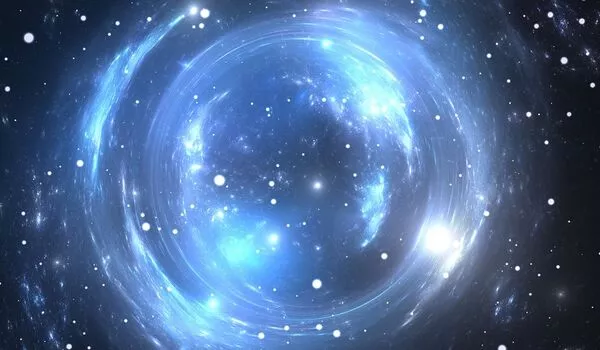The discovery of a supernova explosion via rare “cosmic magnifying glasses” most likely refers to gravitational lensing. Gravitational lensing is a prediction of Albert Einstein’s general theory of relativity that occurs when the gravitational field of a massive object, such as a galaxy or galaxy cluster, bends and distorts light from a distant background object, such as a supernova.
An international team of scientists recently discovered an extremely rare gravitationally lensed supernova known as ‘SN Zwicky.’ The supernova, which was located more than 4 billion light years away, was magnified nearly 25 times by a foreground galaxy acting as a lens. The discovery presents a unique opportunity for astronomers to learn more about the inner cores of galaxies, dark matter and the mechanics behind universe expansion.
Time and space are fused together in a quantity known as spacetime, according to Einstein’s general theory of relativity. According to the theory, massive objects such as galaxies or galaxy clusters can cause spacetime to curve. Gravitational lensing is a rare but observable example of Einstein’s theory in action; the mass of a large celestial body, like a magnifying lens, can significantly bend light as it travels through spacetime. When light from a more distant light source passes through this lens, scientists can use the visual distortions that result to view objects that would otherwise be too far away and too faint to see.
The discovery of SN Zwicky not only showcases the remarkable capabilities of modern astronomical instruments, but it also represents a significant step forward in our quest to understand the fundamental forces shaping our universe.
Ariel Goobar
An international team of scientists, led by University of Maryland astronomer Igor Andreoni, discovered an extremely rare gravitationally lensed supernova known as “SN Zwicky.” The supernova, which was located more than 4 billion light years away, was magnified nearly 25 times by a foreground galaxy acting as a lens. The discovery provides astronomers with a once-in-a-lifetime opportunity to learn more about the inner cores of galaxies, dark matter, and the mechanics of universe expansion. The findings, which included a comprehensive analysis, spectroscopic data, and imaging of SN Zwicky, were published in the journal Nature Astronomy.
“The discovery of SN Zwicky not only showcases the remarkable capabilities of modern astronomical instruments, but it also represents a significant step forward in our quest to understand the fundamental forces shaping our universe,” said the paper’s lead author, Ariel Goobar, who is also the director of the Oskar Klein Centre at Stockholm University.
SN Zwicky was discovered at the Zwicky Transient Facility (ZTF) and quickly identified as an object of interest due to its unusual brightness. The team then observed four images of SN Zwicky taken from different positions in the sky using adaptive optics instruments on the W.M. Keck Observatory, the Very Large Telescopes, and NASA’s Hubble Space Telescope and confirmed that gravitational lensing was responsible for the supernova’s extraordinary radiance.

According to Andreoni, a postdoctoral associate at the University of Maryland’s Department of Astronomy and NASA’s Goddard Space Flight Centre, supernovae like SN Zwicky play an important role in assisting scientists in measuring cosmic distances.
“SN Zwicky is not only magnified by the gravitational lense, but it also belongs to a class of supernovae known as’standard candles,’ because their well-known luminosities can be used to calculate distance in space,” Andreoni explained. “When a light source is farther away, the light is dimmer, similar to seeing candles in a dark room.” We can use this method to compare two light sources and obtain an independent measure of distance without having to study the galaxy itself.”
SN Zwicky, in addition to being useful as a metric for cosmic distance, opens up new research avenues for scientists studying the properties of galaxies, such as dark matter (which is matter that does not absorb, reflect, or emit light but makes up the majority of matter in the universe). Researchers also believe that lensed supernovae, such as SN Zwicky, could be very promising tools for studying dark energy (a mysterious force that opposes gravity and drives the universe’s accelerated expansion) and refining current models describing the universe’s expansion, such as calculating the Hubble constant (a value that describes how fast the universe is expanding).
The team’s success in identifying and analysing SN Zwicky is only the beginning for Andreoni, who is preparing to open the Vera Rubin Observatory in Chile. The new observatory, which is still under construction, is expected to begin full operations in 2024 and will build on the team’s discoveries by taking multiple images of the entire visible sky to search for other supernovae and asteroids. Andreoni believes that the “big picture” approach used to discover SN Zwicky will continue to aid scientists in collecting massive amounts of data about celestial events in the sky.
“This discovery paves the way for future large surveys to find more of these rare lensed supernovae, which will help us study transient astronomical events like supernovae and gamma ray bursts,” Andreoni said. “We are looking forward to making more unexpected discoveries in the sky using broad, untargeted optical surveys like the one that helped us identify SN Zwicky.” We’ll be able to probe the transient sky with unprecedented depth using this method.”





